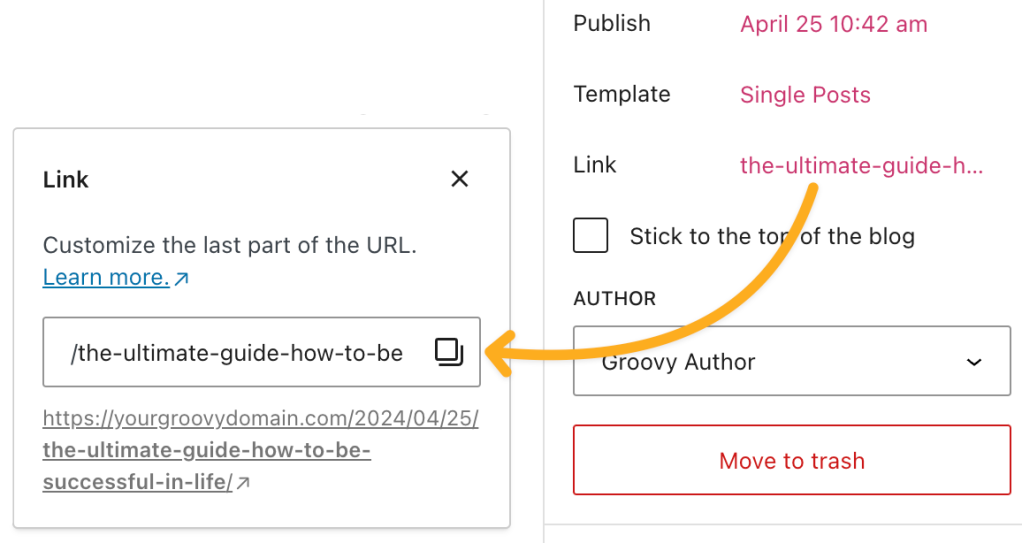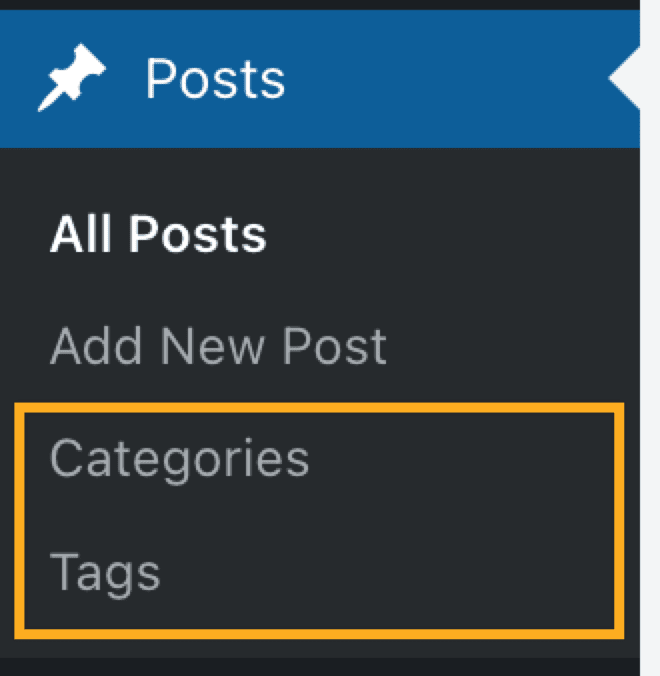A link is the address (also known as a URL or Permalink) of a specific page, post, or other content on your site. In this guide you will learn how to change the last part of the link, sometimes referred to as a slug.
For example, in https://yourgroovydomain.com/2024/01/01/first-blog-post, the “first-blog-post” section of the link is the slug.
In this guide
Learn more about changing the entire URL’s permalink structure instead.
This is an example of a link for a page:
https://yourgroovydomain.com/my-page
This is an example of a link for a blog post:
https://yourgroovydomain.com/2024/01/01/first-blog-post
In the above examples, the last part of the URL address (known as the ‘slug’) is my-page and first-blog-post. The slug is the last part of the URL and refers to that specific page. WordPress automatically generates the slug when you give a page, post, category, or tag a title. For media items, the file name on your computer or device is used for the permalink.
Learn more about changing the entire URL’s permalink structure.
If you create a page called ‘Home’ that is not set as your homepage, the page will receive a slug just like any other page, e.g., https://yourgroovydomain.com/home. Once you set this page as your homepage, the slug will be removed, and the URL will change to just https://yourgroovydomain.com.
No two pages, posts, or media items can share the same permalink address. If WordPress detects the same URL being used more than once, it will add a number to the URL to differentiate it.
For example, if you wrote a post titled “Happy New Year”, the link would use happy-new-year for the last part of the URL. If you were to write a similar post with the same title the following year, the permalink would be happy-new-year-2 to ensure that the two posts have unique addresses. You can change the number to something else by following the steps in the next section.
To change the last part of the URL for a specific page or post , follow these steps:
- In your site’s dashboard, navigate to Pages or Posts.
- Click on the page or post you wish to edit.
- Open the settings sidebar.
If you do not see the sidebar on the right, click the Settings icon in the top right corner to bring up the settings. This icon looks like a square with two uneven columns:

- Under the “Summary” section, locate the Link option. Click on the link in this section to open a pop-over where you can change the last part of the URL.
- Type the new text and click the X to close the pop-over. The permalink will update with the new text.
- Click the “Update” button or “Publish” button to save your changes.

URLs cannot accept certain characters like spaces, punctuation marks, currency symbols, and anything else that isn’t a letter or a number. In those cases, the special character is either replaced with a hyphen ( – ) or omitted from the URL entirely.
Certain words cannot be used as a permalink because the path is reserved for a folder on WordPress sites. These words include avatar, bin, blog-search, forums, gadgets, i, login, m, wp-admin, wp-content, wp-includes, XML, plus any 4 digits (for example, 2024).
Category and Tag pages have a URL structure that looks like this: https://yourgroovydomain.com/category/category-name
In the above example, “category-name” is the slug for the category named “Category Name”. You can change the slug of a category or tag page by changing the name of the category or tag. Learn how to edit a category or tag to change the name.
On plugin-enabled plans, you can edit the slugs used for the URLs independent of the category or tag name.
These instructions are referring to the WP-Admin interface. To view this interface, click the View tab in the upper right corner and select Classic view.
Follow the steps below to view the URLs slugs for category and tag pages.
- Visit your site’s dashboard.
- Navigate to Posts → Categories or Posts → Tags.
- The Slug column will display the last part of the URL used for category and tag pages.


- Hover your mouse over a category or tag and click the “Edit” link.
- Look for the “Name” field.
- Or, on plugin-enabled plans only, look for the “Slug” field.
- Type the new text for your URL.
- Click the “Update” button.
